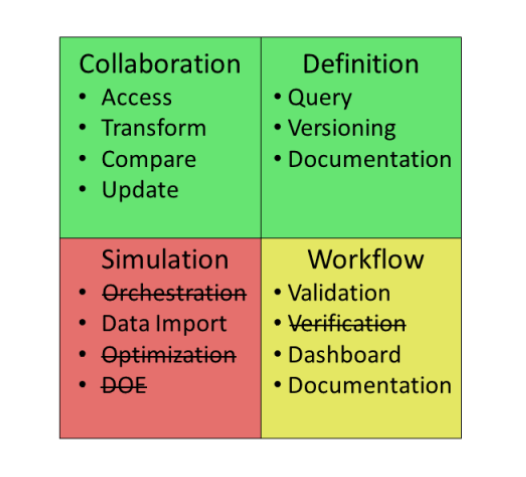As Model-Based Systems Engineering enters the mainstream, an increasing number of integration solutions (IS) have been proposed, causing some confusion particularly among new adopters. In the first three parts of this blog series, we laid out some of the issues that should be considered in picking an IS for your organization. In the next three parts, we will use our Syndeia interoperability platform as an example of how such an evaluation might look. We begin by considering how it supports the four objectives of integration outlined in Part 1.
Syndeia is a framework for system model integration by connecting model elements in different domain models and version-managing those connections. Initially released in 2014, it has evolved in close collaboration with government and private organizations leading the development of MBSE practices for real large-scale projects and is now available commercially in version 3.2.
IS Evaluation Criteria – Objectives
Integration to Support Collaboration
Does the IS allow users to link to and access data in other models?
Yes, Syndeia can create and save “reference” connections between model elements in any of the domain tools supported. These can be used to open the connected elements directly if the user has the correct permissions, accounts and licenses.
Does the IS allow users to transform data from other models into their tool?
Yes, Syndeia can create and save “model transform” connections by dragging model elements in one domain into another. This can include element attributes and relationships.
Does the IS allow users to comment upon or approve/reject data in other models?
No, Syndeia does not support comment/approve/reject workflows for collaboration.
Does the IS allow users to change data in other models?
Yes, model transform connections support compare and update operations between the linked model elements, assuming the user has the correct permissions, accounts and licenses.
Integration to Support Definition
Does the IS allow users to save, visualize and query connections between models?
Syndeia Cloud, the server/cloud-based repository for connections between models, allows sophisticated graph pattern-matching queries to discover extended chains of connections across the federated models.
Does the IS recognize versioning information or content change in connected models?
Yes, Syndeia can recognize changes in the connected element version or content and generate difference tables for analysis.
Does the IS have a mechanism to documenting the total system definition?
Yes, Syndeia can generate tables and diagrams of the federated models based on the connections between them. More generally, the open API for Syndeia Cloud allows external applications such as OpenMBEE or Jupyter notebooks to access, display and document this information in a variety of user-friendly formats.
Integration to Support Simulation
Does the IS define and execute data transfer between existing analysis/simulation models?
No, Syndeia does not orchestrate multiple simulations by pipelining outputs and inputs between analysis models.
Does the IS allow import of data from existing design models and databases?
Syndeia can share property values using model transforms, but does not automatically import those values into analysis models during simulations.
Does the IS have tools to automate optimization and DOE for the system simulation?
No, Syndeia does not perform optimization or DOE for simulations.
Integration to Support Workflow
Does the IS automate the validation of the system model?
Yes, Syndeia can support validation of the system through checking for connection patterns, e.g. is each requirement satisfied by a system element and verified by a testcase? Automation is provided through external applications that store and execute the validation queries.
Does the IS automate the verification of the system model against requirements?
No, Syndeia does not support automated requirements verification.
Does the system have a dashboard displaying system model metrics?
Yes, Syndeia Cloud provides a dashboard displaying metrics for the federated models.
Does the system automate the documentation of the system model?
Yes, queries to Syndeia Cloud provide the content of the documentation, while external applications such as OpenMBEE provide the automation and formatting.

Figure 1 Syndeia scoring against Objectives
One approach to visualizing the results of this part of the evaluation, as shown in Figure 1, shows the four objectives as four quadrants. Syndeia meets many of the needs for Collaboration and Definition and these quadrants are shown as green. The simulation area is red; Syndeia does not have the features to support the orchestration of multiple analyses with optimization and design of experiments. Other integration solutions, e.g. ModelCenter (Phoenix Integration), Simulia (Dassault Systemes) and others, may be a better fit for users with that objective. Workflow is shown as yellow; Syndeia supports many of the standard tasks but may require outside scripting for task automation.
In the next two posts in this blog series, I will evaluate our Syndeia interoperability platform with respect to Technical Approaches and Other Requirements, following the outlines in the earlier Parts 2 and 3.
Related Posts:
- MBSE and Integration | Part 1
- MBSE and Integration | Part 2
- MBSE and Integration | Part 3
- MBSE and Integration | Part 4 (this post)
- MBSE and Integration | Part 5
- MBSE and Integration | Part 6
 Intercax
Intercax Intercax
Intercax